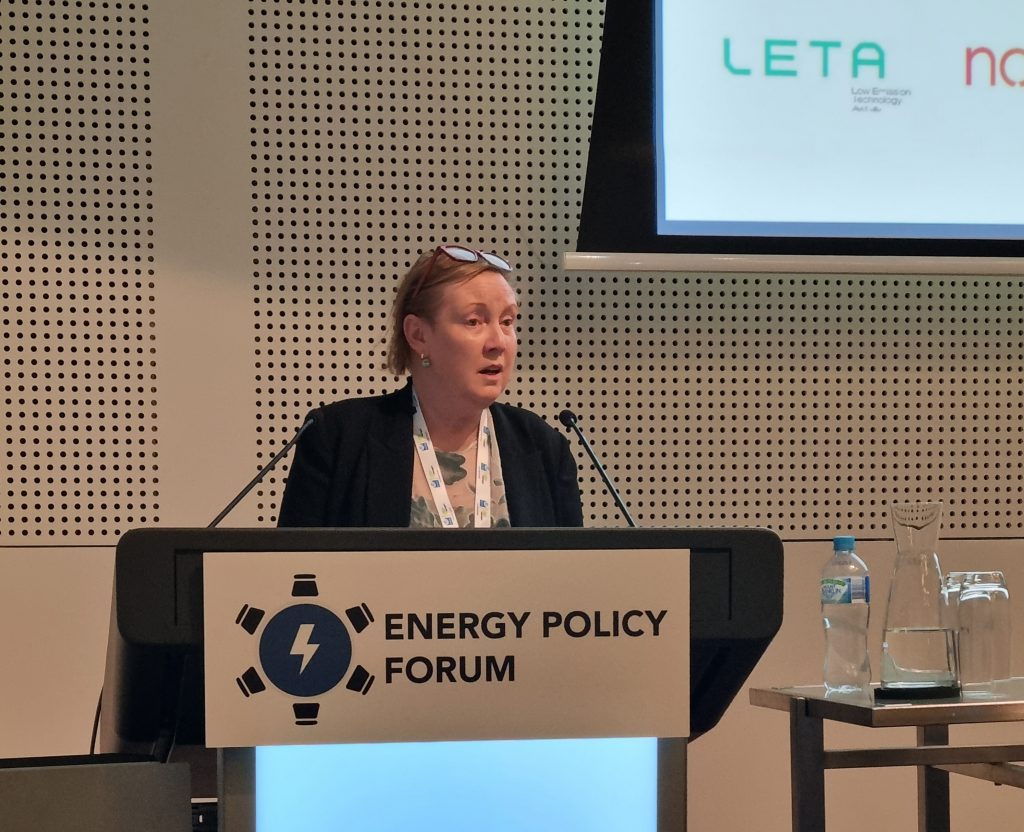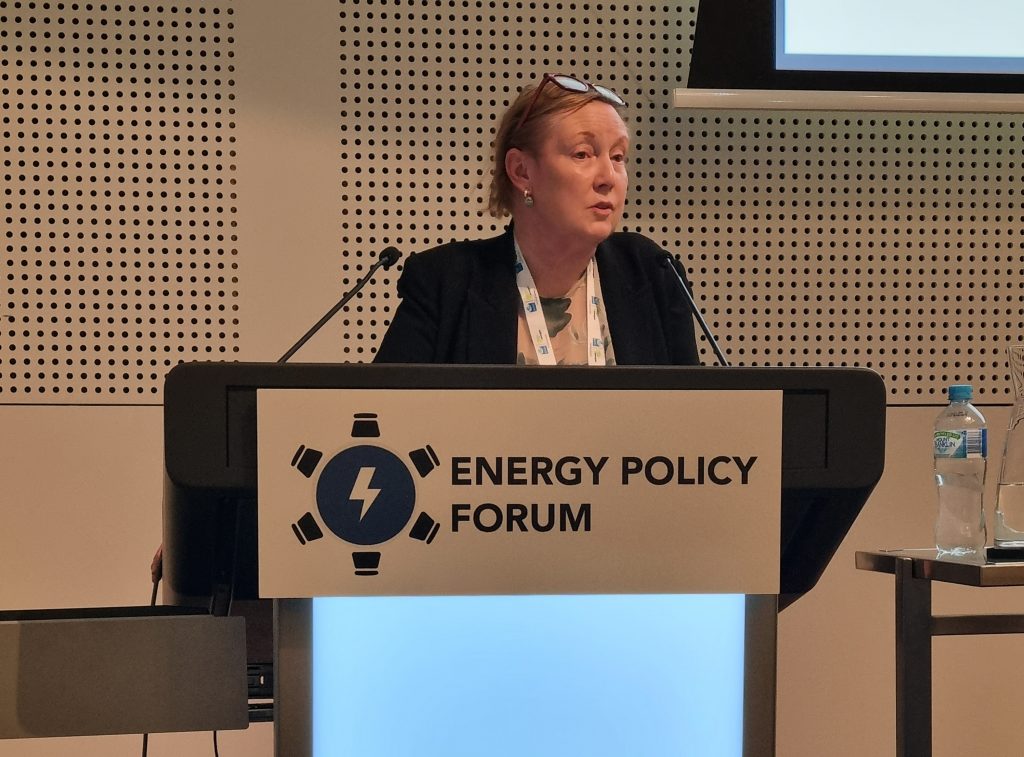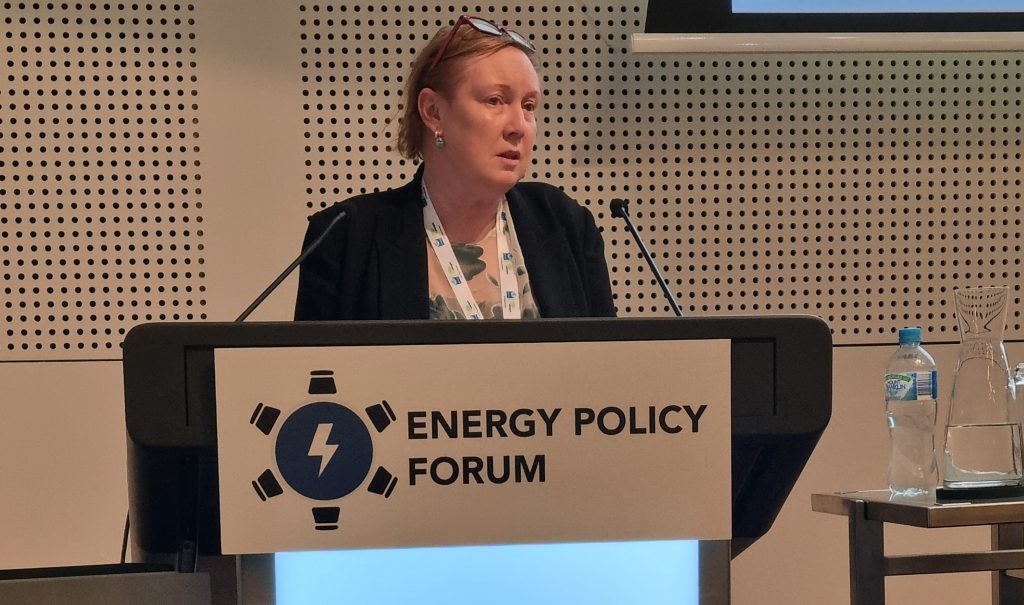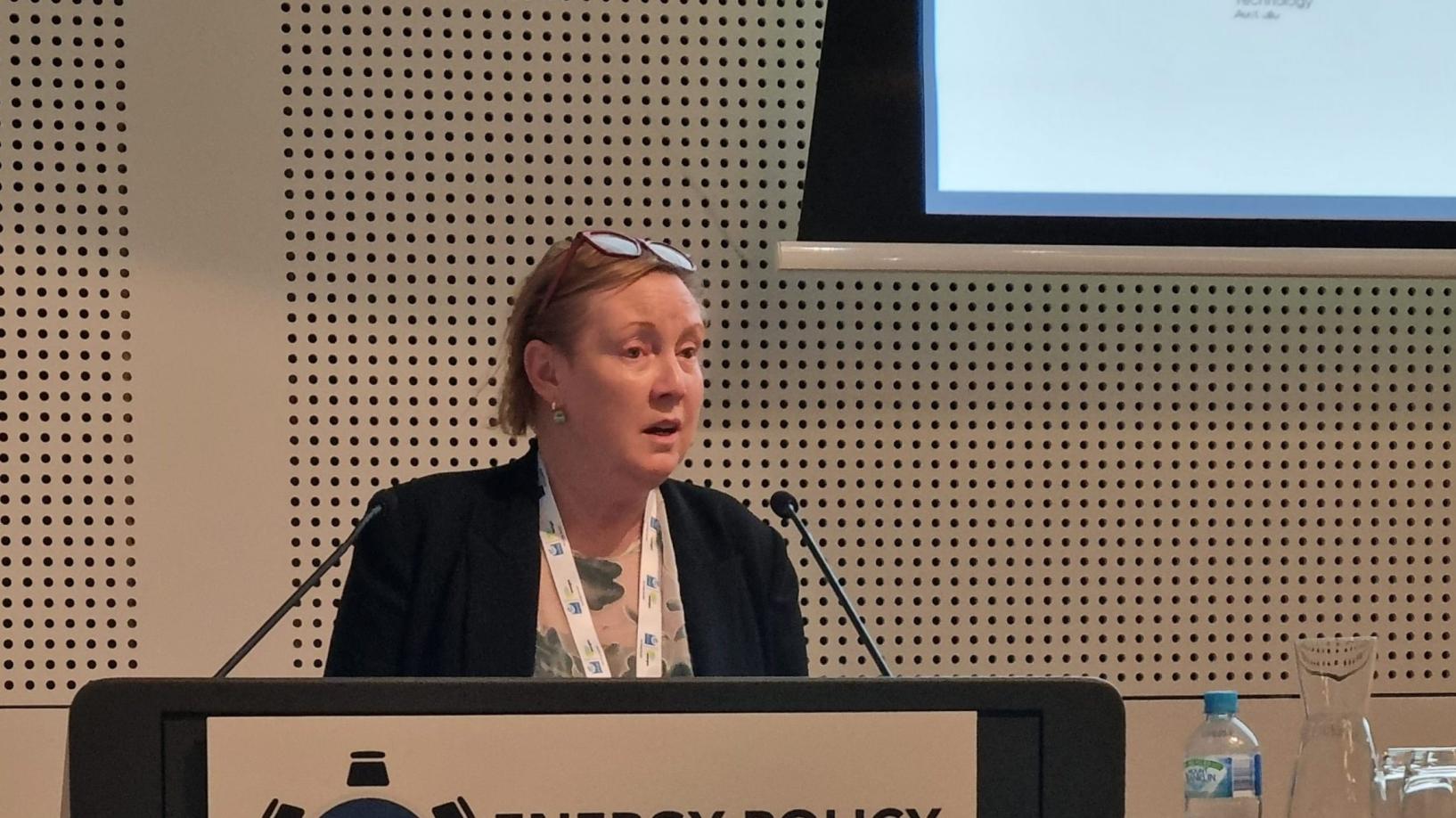Energy Consumers Australia Chief Executive Officer Lynne Gallagher delivered this keynote address at Australian Energy Week in Melbourne on 9 June.
I would like to begin by acknowledging that I am on the lands of the Wurundjeri people of the Kulin nations, whose sovereignty was never ceded.
In a different context I would also like to recognise the achievements of yesterday’s meeting of Commonwealth, State and Territory Ministers in uniting around a set of actions to address critical issues in our energy system transition.
As its after lunch, I think we need some audience participation.
Can you put your hand up if you are worried about paying your next electricity or gas bill?
If that’s not you, can you put your hand up if you are worried that someone you know or care about could struggle to pay their next bill, or the one after that?
Make no mistake, energy prices are compounding the cost of living issues for our 10 million households and 2.6 million small and medium business owners.
We need to understand that the averages often talked about disguise why people are feeling under pressure.
Above incomes of $120,000 a year, households are paying around 2% of their income on electricity.
Below that it’s a different story.
Households can pay from 3% for middle income households up to 7% or more for those on the lowest incomes. And those on the lowest incomes have the highest housing costs – usually well above 30% of their income.
One other thing I want to say. I could have asked everyone who believes action is needed urgently to address climate change to yell out – “Hell yeah” – but Australians did that at the ballot box a few weekends ago.
Its not either or. Its affordability and a clean energy future.
Now, I have been around the energy world for a while and it sometimes feels like our system is one big pendulum, swinging between the short term and the long term.
Between the immediate pressures of the moment and the transformative task of where we need to be in 2030, 2040 or 2050.
When affordability is threatened, we retreat into the now. Consumers get worried. Political leaders get nervous. We speak about crisis and we’ll do anything to put out the fire.
When things stabilise, we start to think and talk about the future again in terms of possibility and potential.
But while it’s important to be helping consumers in the moment with their very real distress…
We also need to plan for the future with the same laser focus on affordability that we all feel today.
Energy Consumers Australia was created seven years ago. We were born out of a moment where political leaders realised that in failing to put the focus on affordability and consumers needs and expectations there had been real damage.

Consumer voices needed to be included at the heart of energy market design, planning and operations to make sure it didn’t happen again. Achieving that shift has been our mission.
Today, I want to say to you that we are again at a point where this could happen again. After ten years when electricity prices have stayed high, choices lie before us that could deliver a decade of pain for everyday Australians in the form of continued high prices and energy bills, and poor consumer outcomes.
Only this time we are here to say this is not an option.
The good news is, when it comes to what we call the first transition, the technological shift to a net zero energy system, we mostly know what that needs to look like.
The bad news is that the biggest challenge we face is something that is not being talked about or thought about nearly enough. It’s not the light on the hill of 2050, where abundant renewable electricity backed by ample storage powers our homes, businesses and transport.
It’s the next 10-15 years.
It’s how we can possibly build and create the future system in a way that keeps energy affordable for everybody while we are doing it. That involves what we call ‘the second transition’ – the changes that will be required in the lives and livelihoods, behaviours and preferences of everyday people.
The title of this session mentions ‘A Just Transition’. The alternative now is not ‘no transition’.
The alternative is a transition that delivers on our aspirations to address climate change through renewable energy but leaves significant parts of our community feeling left behind.
Not a just transition. Just a transition.

Much of the energy discussion right now centres on securing massive investment in transmission, along with additional generation and storage, so that our grid can accommodate 100% renewable electricity in the future. The new government has promised $20 billion under its Rewiring the Nation plan to make this happen.
I’m here today to say that we can argue about the quantum, about how much investment is too much or just right - and we should because total system costs matter.
It is necessary but, on its own, it will not be sufficient.
We can spend and build our way to a transition that delivers clean, abundant energy for all and meets our Net Zero obligations. And eventually, once all the infrastructure is delivered, electricity will be cheaper.
But over the next 10-15 years, the costs of creating this new system will be passed back to consumers as higher bills. Believe me, that will be a problem.
We’ve seen in the past fortnight the anxiety and urgent activity that gets unleashed when consumers see prices beginning to rise. It’s not a comfortable place to be, for governments or for consumers.
If we want energy to actually be affordable while we undergo this transition (and we really ought to) then there are some things we need to prioritise, that we are hardly even talking about.
What are they?
In the past couple of weeks, as electricity and gas prices have been rising, I’ve been doing quite a lot of media interviews. News outlets have wanted me to share my tips and advice for how households and small businesses can make changes to feel in control and to reduce their bills.
That mostly means trying to make your house (or your place of work if you are a small business) more efficient so that you remain comfortable while not using any more energy than you absolutely need to.
I’ve been calling them ‘grandma’s home hacks’.
It turns out the challenge for energy leaders and expert advisers is pretty similar.
That’s right, all you engineers, economists and policy experts out there… we need some cutting-edge grandma thinking at the heart of our energy transition.
I can say that because I am a proud grandmother myself.
(Also a sort-of-proud economist)
One thing that both grandmas and economists appreciate is efficiency. We need to get much smarter about how we use the energy and resources we already have in our system. And that means engaging with the people who own and use those Consumer Energy Resources – everyday Australians.
The task ahead is massive, as energy leaders like Anna Collyer, Clare Savage and Daniel Westerman have stressed this week. It requires bold and brave thinking.
So today I’m going to put forward three big areas where we need to raise our eyes and have the courage to be far more ambitious.
As a nation, we are putting $20 billion into supply side solutions, in the form of Rewiring the Nation.
How much are we putting into the demand side? Into households and small businesses? Into consumers’ homes, choices and preferences?
Small change.

The first big change we need is to fix up our housing. We don’t just need to rewire the nation, we need to insulate it – with an ambitious but realistic push to retrofit almost all of our 10 million homes.
In 2009, Barack Obama declared that insulation was ‘’sexy stuff’. I’m inclined to agree.
Australians live in some of the most energy inefficient homes in the developed world. More people die from exposure to the cold in this country each year than in Sweden.
If that sounds crazy, guess what? It is.
The average tent has an energy efficiency rating of zero stars. It will essentially be the same temperature outside as within. A top of the range energy efficient house will have a ten-star rating, while most new homes built in the past decade are rated six stars.
The average energy efficiency rating for 8 million older existing homes (the ones most of us live in) is 1.7 stars.
Much closer to a tent than to an energy efficient home.
That should be a cause for national embarrassment and a huge motivator to be more ambitious. In a hot country that is only getting hotter we know these homes are less healthy to live in and more expensive to run.
We also know that often the Australians who can least afford it are subjected to higher energy bills because they are heating or cooling leaky, draughty boxes.
As a nation we’ve led the world in adoption of rooftop solar. But too often we are placing solar panels on the roof of a tent. Adequately insulating our existing homes is an inclusive way of sharing the benefits of the energy transition more broadly across the community.
Millions of Australians who rent, who live in apartments or who have low incomes have been unable to participate in the rooftop solar revolution. If we do not cater to them they will be left as the remaining customers for expensive legacy products and services while those who are able to add rooftop solar prosper in the new economy.
A Renovate Australia program to retrofit 8 million homes would be a huge challenge. But so is building out the transmission network. It would be expensive. But so are the supply side remedies being put forward right now.
The benefits would be enormous. We’d be creating a whole new industry of skilled workers, manufacturing of products here in Australia and services. We’d be providing millions of Australians with healthier and more comfortable places to live, while also keeping their energy bills lower.
How should we start?
There are around 430,000 social housing dwellings across Australia, and another 100,000 families are in private rental accommodation receiving assistance.
If we spent $7,000 fitting each one with better insulation the total price tag would be $3.7 billion. It’s a lot but it’s a fraction of what we’re already committed to spending on new transmission.
What if we just said: ‘Let’s do it’?
The second idea I want to put forward is around storage. In short, we are going to need a lot of it, but where?
The Australian Energy Market Operator says we need about 8GW of ‘residential storage’ by 2030 under the ‘step change’ scenario in its Integrated System Plan (ISP).
It assumes there will be around 2 million household batteries across Australia to provide it.
That’s on top of large-scale storage, the Snowy 2.0 scheme and other forms of storage like Electric Vehicles.
In decades to come, we’ll need even more.
We say that tackling the nation’s storage one garage wall at a time is remarkably inefficient -- wasteful even.
It’s also a pretty tall order. Australians currently buy about 30,000 home batteries a year. At that rate, it would take around 65 years to reach the number AEMO says we’ll have in 2030.
Now remember that each of those batteries represents a substantial investment by a consumer (currently around $12,000). So if the ISP is right, we are looking at around a $15 billion tab being picked up by everyday Australians.
And what would they get for their money? A battery sitting in their garage (for those that have one) that is mostly not being used for most of the time.
Again, it’s crazy.
It would make far more sense to dramatically scale up the role we are allocating to local or “distributed” batteries in the energy system we are building. That’s why we were really pleased to see a commitment to rolling out community batteries as part of the Albanese Government’s platform.
It’s a good start but we need much more. And fast.
It seems pretty obvious that creating batteries as a shared resource and being able to likewise share the costs is a better idea than making each household assume responsibility for adding their own storage and then washing our hands of those who cannot participate.
The third big thing I want to talk about is electric vehicle charging.
The Albanese Government has a plan to introduce tax breaks to incentivise EV uptake, predicting that 89% of new car sales will be EVs by 2030.
That’s laudable. But is it ambitious enough?
The point of switching to EVs is to electrify our transport so that, as we move our grid to 100% renewables, our ability to move around is decoupled from fossil fuels.
The most important thing about EVs – if they are to be a boon for the system rather than an impost – is where and when they get charged. If millions of Australians drive their EV to work, park it all day, drive home and charge it at 6:30pm we could be creating a new superclass of demand that only exacerbates the problems we already face.
But if most EV drivers charge their vehicles during the day when the sun is shining and electricity is plentiful and cheap, travel costs will be lower and our grid will be more balanced (and therefore more reliable and secure).
We say the key to EV success is ubiquitous charging. During the day, when electricity is virtually a waste product, it should be cheap, easy and convenient to charge your vehicle wherever you are. At work. At the shops. At the gym. Everywhere.
Charging is the EV secret sauce.

Researchers at MIT actually modelled this not too long ago.
They looked at one scenario where $10,000 incentives were put in place to encourage people to buy an EV and funding was allocated for 50,000 new charging stations over 5 years across the US.
The modelling showed an initial boost to uptake but EV penetration topped out at 6% of all vehicles. After a decade, sales began to decline and after 25 years, the researchers predicted, EVs would have disappeared from American roads.
The second scenario they modelled included the same incentives to purchase but doubled the amount of charging stations built to 100,000.
Under this scenario, EVs reached 10% penetration after ten years and continued to grow from that point.
The lesson here was clear… subsidising the price of EV’s matters, but not as much as making sure we are investing in charging stations. This is another area where our ambitions need to be much greater.
For comparison, Australia currently has around 3000 public EV charging points across its 7.7 million square kilometres. Good luck finding one.
Under its Driving the Nation plan the Albanese government has committed to spending $39.3 million on building a charging network, with chargers located every 150km on major highways between states. That’s great, but to say this is a drop in the ocean might be to overstate it.
We need so much more.
Again, doing this right will be big and expensive – but so are the consequences if we don’t.
I’ve shared three big ideas with you today but there is one thread that unites them.
Right now we are seeing the pain that accompanies high energy prices and high bills for consumers. If we want to avoid hard-wiring that pain into our system for the next decade and a half we need to make sure that energy is affordable for everybody during that time.
I keep hearing that there is no transition without transmission. I’m here to tell you there can be no solution without inclusion.
That means investment in storage that is available to everybody. It means dramatic expansion of the EV charging network so that EVs are easy and affordable options for most Australians.
And it means overhauling millions of inefficient homes so that we are not using more energy than we need to and all Australians can live in comfort and good health.
Only when we start taking these challenges more seriously can we say we are en-route to a just transition, rather than just a transition -- a shift that does not care who is hurt along the way.
I will end there and if there is time, I am happy to take questions.
